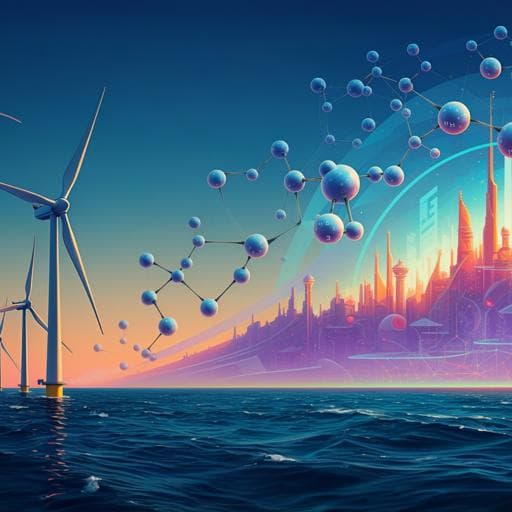
Engineering and Technology
Production of hydrogen from offshore wind in China and cost-competitive supply to Japan
S. Song, H. Lin, et al.
This exciting research, conducted by Shaojie Song, Haiyang Lin, Peter Sherman, Xi Yang, Chris P. Nielsen, Xinyu Chen, and Michael B. McElroy, delves into the potential of producing green hydrogen from offshore wind in China to meet Japan's future energy needs. Discover how this innovative solution could impact costs and energy strategies between these nations.
~3 min • Beginner • English
Introduction
Japan aims for net-zero greenhouse gas emissions by 2050 and foresees hydrogen as a key energy vector, especially for decarbonizing power, heavy industry, and transport. Current hydrogen use in Japan is ~1.3 Mt/yr, mostly for industrial applications, with a government target of 3 Mt/yr by 2030 and 20 Mt/yr by 2050. Japan’s price targets for low-carbon hydrogen are $3/kg by 2030 and $2/kg by 2050, intended to be competitive with natural gas on an energy basis. Domestic green hydrogen production is projected to be expensive (~$6/kg in 2030), motivating imports. This study investigates whether green hydrogen produced via electrolysis powered by China’s offshore wind could supply Japan at scale and at or below these cost targets, assessing multiple carriers (liquid hydrogen, methylcyclohexane via toluene, and ammonia) and considering full supply-chain costs.
Literature Review
The paper situates its analysis within prior work on hydrogen pathways and costs, including IEA assessments of hydrogen production types (gray/black/blue/green) and projected import costs from regions such as Australia, New Zealand, Brunei, Saudi Arabia, and Norway. It cites prior analyses indicating that Chinese offshore wind could be cost-competitive with coal and nuclear before 2030 and notes Japan’s ongoing efforts to develop liquid hydrogen shipping and LOHC demonstrations (e.g., Brunei–Japan MCH project). It references technology baselines from NREL and DOE/NEDO reports for cost and performance assumptions across wind, electrolysis, conversion, storage, and shipping.
Methodology
The study performs a techno-economic optimization of a China-to-Japan green hydrogen supply chain on an hourly basis across all feasible Chinese coastal offshore wind areas. Key elements include: (1) Offshore wind resource modeling using NASA MERRA-2 reanalysis (hourly, 1990–2019) at ~0.625°×0.5° resolution, mapped to 0.1°×0.1° grids within China’s EEZ and ≤60 m water depth (fixed-bottom turbines), excluding special marine reserves and shipping routes. Wind power output is computed using MHI Vestas V164-8 MW (and sensitivity to 9.5 MW), with turbine spacing of 7×7 rotor diameters; wake losses are not explicitly modeled. Offshore wind CAPEX trajectories (high/moderate/low) follow NREL ATB 2020 with spatial adjustments for depth and distance to shore; O&M is 2% of CAPEX; 20-year project life. (2) Electrolysis options include AEC (baseline, mature and low-cost in China), PEMEC, and SOEC, with CAPEX/O&M and efficiency projections from IEA/BNEF. Electrolyzers are centralized onshore; freshwater demand is met via seawater desalination at < $1/m3; oxygen byproduct revenues ($40/ton) are credited. (3) Hydrogen conversion pathways: liquefaction to liquid H2; hydrogenation to MCH (toluene LOHC); synthesis to ammonia (with ASU). Conversion plant sizing, load constraints, and performance are based on DOE/NEDO; liquefaction energy ~12 kWh/kg H2 (with future improvements). (4) Storage: post-electrolysis gaseous H2 storage (pressurized tanks baseline; salt caverns as sensitivity), carrier storage (MCH, NH3, LH2), and ~7-day buffer storage at port; boil-off and losses from NEDO. (5) Transport: maritime shipping of LH2 (KHI concept), MCH (via oil tankers), and ammonia (existing infrastructure). Costs draw on NEDO and literature for ships, loading/unloading pumps, and voyage distances/times. (6) Dehydrogenation in Japan for MCH and ammonia considers three heat sources: industrial waste heat (baseline), combustion of H2/NH3, or natural gas; also considers direct use of ammonia without cracking. (7) Optimization: A least-cost model (MATLAB/Simulink 2020b) jointly optimizes investments and hourly operations for wind deployment, electrolysis, conversion, storage, and shipping to minimize levelized cost of hydrogen (LCOH) delivered to Japan for target demand levels (2030: 3 Mt/yr; 2050: 20 Mt/yr, with higher scenarios explored). All monetary values are in 2020 USD; discount rate 7%; Chinese and Japanese grid electricity prices assumed at $0.10/kWh and $0.16/kWh for relevant processes.
Key Findings
- Supply curve results (baseline): Among transport mechanisms, MCH is the least-cost option, followed by ammonia, ammonia with dehydrogenation, and liquid hydrogen. - Achievable LCOH: Meeting Japan’s targets, hydrogen via MCH can be delivered at ~$2.0/kg (3 Mt/yr in 2030) and ~$1.8/kg (20 Mt/yr in 2050), undercutting Japan’s targets of $3/kg (2030) and $2/kg (2050). Salt cavern storage in China further lowers LCOH and makes liquid hydrogen more competitive by 2050. - Scale: China’s offshore wind could supply beyond 20 Mt/yr; even a 40 Mt/yr demand in 2050 could be met at < $2/kg, particularly via MCH or direct-use ammonia when waste heat for dehydrogenation is unavailable. - Spatial distribution: Lowest costs are concentrated off Fujian, with substantial additional low-cost potential from Liaoning, Zhejiang, and Shandong. A single province (Fujian) could meet Japan’s projected 2050 demand. Example cost-competitive potentials (LCOH threshold $3/kg in 2030 and $2/kg in 2050, MCH): Fujian 28.2±6.0 Mt/yr (2030), 21.2±6.9 Mt/yr (2050); Liaoning 16.9±4.1 (2030), 11.2±4.2 (2050); Zhejiang 15.8±4.7 (2030), 10.1±4.9 (2050); Shandong 8.6±4.5 (2030), 3.0±2.5 (2050). - Cost breakdown: Hydrogen production dominates LCOH (≈47–70%), conversion (hydrogenation/dehydrogenation, liquefaction, ammonia synthesis) contributes ~19–35%, while storage and transport are modest shares; transport costs are low due to short China–Japan routes. - Robustness: Even with higher offshore wind costs and with alternative electrolyzers (PEMEC, SOEC), LCOH remains within Japan’s targets for 2030–2050. - Policy relevance: Imported green hydrogen from China is projected cheaper than domestic Japanese production and imports from more distant sources (e.g., Australia, Norway, Middle East) for both green and blue hydrogen in 2030–2050.
Discussion
Findings indicate that Chinese offshore wind–derived green hydrogen could be supplied to Japan in volumes sufficient to meet or exceed stated 2030 and 2050 targets at or below target prices, particularly via the MCH route. The relatively shallow Chinese EEZ with large areas <60 m depth and short shipping distances confer cost advantages. Cost decomposition highlights the primacy of production costs and the importance of conversion efficiency and dehydrogenation heat sources; leveraging industrial waste heat in Japan further reduces delivered costs. The spatial analysis suggests diversified sourcing across several Chinese provinces, with Fujian offering especially favorable economics and scale, enhancing supply resilience. Compared with other import pathways, the China–Japan supply chain supports Japan’s energy security and affordability objectives while advancing decarbonization. The approach also suggests opportunities for regional cooperation, technology deployment (e.g., fuel cells), and potential extension to Korea. Sensitivity analyses and storage options (e.g., salt caverns) show additional cost reductions and flexibility, while direct ammonia use can hedge against limited waste heat for cracking.
Conclusion
A detailed, hourly-resolved techno-economic optimization shows that green hydrogen produced via electrolysis powered by China’s offshore wind can be delivered to Japan at large scale and competitive costs. The MCH pathway is identified as the least-cost option, achieving about $2.0/kg by 2030 for 3 Mt/yr and ~$1.8/kg by 2050 for 20 Mt/yr, with potential to supply up to ~40 Mt/yr below $2/kg in 2050. Storage in salt caverns and other technology advances could further reduce costs; direct use of ammonia provides a robust alternative when dehydrogenation heat is constrained. The study supports the feasibility of a cost-competitive, low-carbon hydrogen import strategy for Japan and underscores the strategic value of regional collaboration. Future work could assess underwater pipeline transport, floating offshore wind enabling deeper sites, larger turbines (15–20 MW), detailed wake interactions, and expanded geological storage mapping.
Limitations
- Assumes fixed-bottom offshore wind limited to ≤60 m water depth; deeper-water floating wind is excluded and could change costs and resource size. - Wake losses are not explicitly modeled due to resolution limits, potentially modestly overstating generation. - Baseline relies on AEC electrolyzers onshore; offshore electrolysis at wind farms is not modeled. - Dehydrogenation cost assumptions include availability of industrial waste heat; availability may be location- and time-dependent. - Cost projections (wind, electrolysis, conversion, storage, shipping) rely on NREL/DOE/IEA/NEDO forecasts with inherent uncertainty. - Assumes oxygen byproduct can be monetized at $40/ton; market dynamics could vary. - Transport assessment focuses on shipping; underwater pipeline option is noted but not modeled. - Interannual variability is considered, but broader climate change impacts on wind regimes are not explicitly modeled. - Grid electricity prices for auxiliary processes are fixed assumptions ($0.10/kWh China; $0.16/kWh Japan).
Related Publications
Explore these studies to deepen your understanding of the subject.







